
Garden and Plate
The Molecular Biology of Nutrition










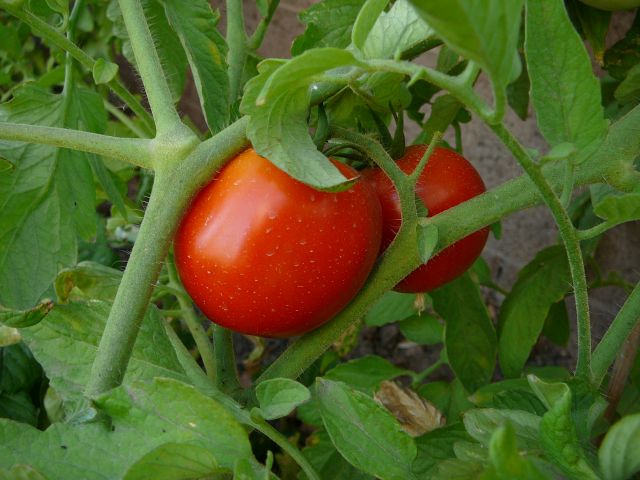
Growing tomatoes in the Arizona desert is a race against time. While many parts of the world have one long summer in which to grow tomatoes, the Phoenix area has two short growing seasons. We start earlier than other climates, since the ground warms up in early March, but the first season ends in early July, when the temperatures go over 110 degrees Farenheit. While tomatoes are summer crops, there's only so much heat they can take. Once it gets too hot, they stop producing flowers, the existing fruit gets sunburned, and the entire plant gets stressed. If you nurse the plant through the summer, though, it will come back in the fall.
The first growing season is sandwiched between the mild (yet too cold for tomatoes) winter, and the too hot summer. The ground doesn't warm up enough for seed germination until early March, and the plants get cooked in early July. This gives us four months at most, which rules out all but the quick growing varieties. While four months is more than enough time to get your first ripe tomato, the idea is to get as many weeks of ripe tomato production as you can before the heat shows up. Tomatoes aren't peaches, they don't all ripen at once. The tomato plants produce new fruit continuously. It's not worth all the trouble if you only get a couple weeks of production.
The large "Beef-stake" type tomatoes don't do well in Arizona, so I don't grow them. I grow either medium or cherry sized tomatoes. The medium-size tomatoes I grow are the short-season varieties, usually either "Early Girl" or "Better Boy". I've grown them from seed, and have also purchased the small plants at a nursery. Either way, I put the plants in the garden in early March (or late February, weather permitting). They start producing ripe tomatoes in late May, and continue producing until it gets too hot in late June or early July. You get maybe six weeks of ripe tomatoes. If you grow from seeds, you'll have to start them inside the house in January, and transplant them into the garden in early March. There's not enough time if you plant the seeds in the garden in early March, and the soil is too cold before then.
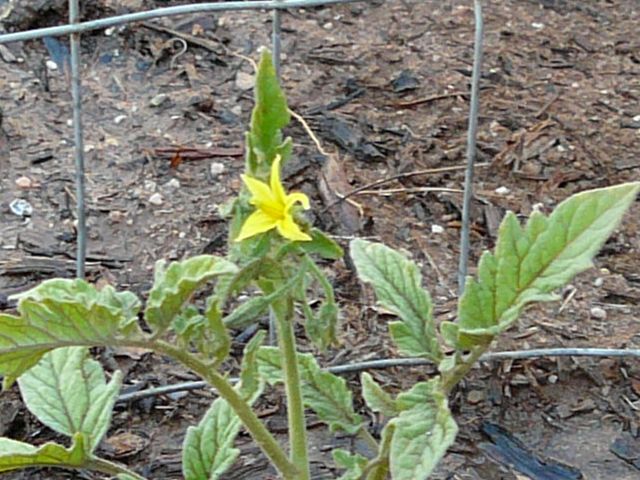
The second growing season starts when the temperatures begin to cool off in mid September, and continues until the first freeze. You can either buy new plants or stick with your old plants that survived the summer, but once again there's not enough time to plant seeds. The seeds will germinate, but you probably won't have ripe fruit before the first freeze kills them. A freeze can happen as early as October, but may not happen until Thanksgiving (or even later), so it's a race against time once again. Even without a killing frost, the tomatoes won't ripen on the vine if it gets too cool. I've usually ended up with lots of green tomatoes that have to be brought into the house (where it's warmer) to ripen. I usually grow tomatoes in the spring, and then remove them in the summer to make room for planting snow peas in October. I've never had good, ripe tomatoes in the fall, but some people do.
I've also grown cherry tomatoes (see the side panel), which I usually start from seed. The nurseries sell a few varieties of cherry tomatoes in pony packs, (which I've used on occasion), but if you want to grow something unusual, you have to send away for seeds. I did this with the "Egg Yolk" and "Fox" cherry tomatoes (see side panel) one year when I wanted to try something new. I started them inside the house in January, and moved them into the garden in early March. They both turned out OK.
Many home-grown fruits and vegetables taste better than the ones you get at the store, but this is especially true with tomatoes. Home-grown Tomatoes have alot more flavor than the ones you normally find in a store because the store-bought tomatoes are picked green, rather than vine-ripened. They ripen either way, but when ripened off the vine, they don't have access to nutrients from the plant. This makes a big difference with tomatoes.

Above, a Tomato Hornworm is having lunch. Below, you can see it's droppings. The black droppings are easier to spot than the worm, so look for them first.
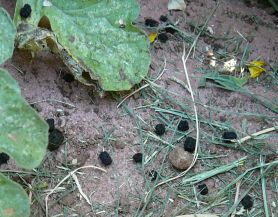
A pest that shows up in my garden every year is the Tomato Hornworm. These are large green catapillars that are over 3 inches long when fully grown. They'll strip tomato and bell pepper plants (They don't bother the jalapeno pepper plants) bare if you don't watch out for them. Even when they are large, they are hard to spot, since they are the same shade of green as the leaves and stems they consume. The best way to know if there are any Tomato Hornworms on your plant is to look for their droppings on the ground. If you see the droppings, look for stripped areas on the plant. When you find the hornworm, the tug of war begins. It has lots of feet, and they all grasp the stem tightly. If it's near the top of an already stripped stem, I usually just cut the stem off, and throw the it away with the Hornworm still attached. If I don't want to remove the stem it's on, I pry it loose with a stick. I don't know if they bite fingers, but judging from the devoured stems it's safe to say they have the teeth for it. The "Horn" that looks like a tail is just for show, and doesn't sting. Here's a picture with a better background.
I've also had some problems with birds eating my tomatoes, but it's usually been late in the season when it's hot outside. I don't know if the birds are after the tomatoes, or the moisture they contain. Putting bird netting over the plants is one solution. Planting sunflowers is another. I've found that planting sunflowers near the tomato plants helps reduce the bird-caused damage to the tomatoes. Birds love sunflower seeds, and don't pay much attention to the tomatoes when ripe sunflower seeds are available. Sunflower seeds ripen the same time that tomatoes do, so it works out well.
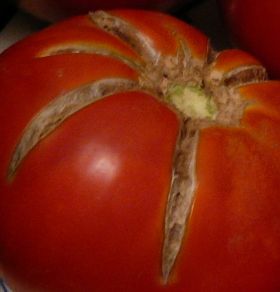
Pests aren't the only problems you have with tomatoes. Uneven watering can cause the skin on tomatoes to crack. The skin on the tomato dries out when the plant doesn't get enough water, then cracks as it gets larger. Also, when the weather gets hot (usually in early July), the sun can literally cook the tomatoes, creating burnt spots on the fruit that causes it to rot. Even though tomatoes need sun to be healthy, they can get too much of a good thing when temperatures top 110 degrees. You can prevent damage for awhile by using shade screen in the afternoons. Better yet, plant the tomatoes on the east side of a wall so they get the morning sun and afternoon shade. Even when you do this, though, the hot Phoenix summer will eventually stress the plant, and it will stop producing fruit until things cool down in the fall.

The seeds (from Baker Creek) for these "Egg Yolk" cherry tomatoes were planted indoors on February 2nd. I transplanted the seedlings into the garden on March 14th. These two photos were taken on July 12th, near the end of their spring season. Cherry tomatoes hold up against the summer heat longer than the larger tomatoes, but these plants will soon stop producing due to stress from the summer heat.

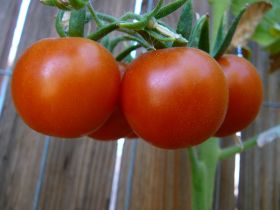
This photo of a cluster of Fox cherry tomatoes was taken on July 12th, near the end of the spring season for tomatoes.
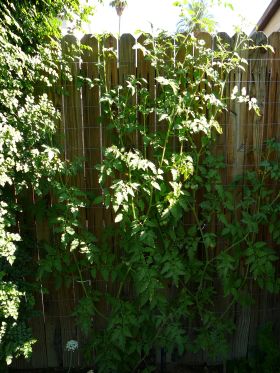
The Fox cherry tomatoes are small, but the plants are big. This June 15th picture shows the Fox cherry vines topping a 6ft fence.